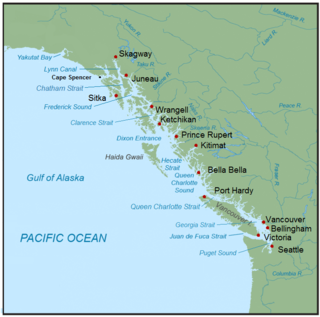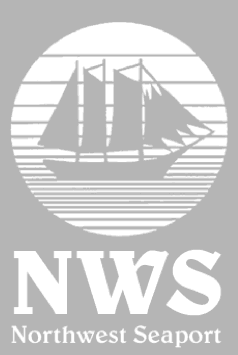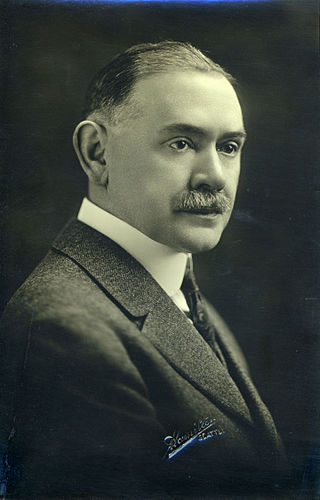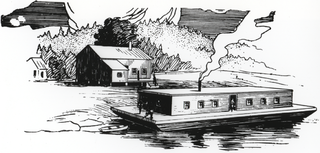Related Research Articles

Dillingham, also known as Curyung, is a city in Dillingham Census Area, Alaska, United States. Incorporated in 1963, it is an important commercial fishing port on Nushagak Bay. As of the 2020 census, the population of the city was 2,249, down from 2,329 in 2010.

The Inside Passage is a coastal route for ships and boats along a network of passages which weave through the islands on the Pacific Northwest coast of the North American Fjordland. The route extends from southeastern Alaska in the United States, through western British Columbia in Canada, to northwestern Washington state in the United States. Ships using the route can avoid some of the bad weather in the open ocean and may visit some of the many isolated communities along the route. The Inside Passage is heavily travelled by cruise ships, freighters, tugs with tows, fishing craft, pleasure craft, and ships of the Alaska Marine Highway, BC Ferries, and Washington State Ferries systems. Coast Guard vessels of both Canada and the United States patrol and transit in the Passage.

Northwest Seaport Maritime Heritage Center is a nonprofit organization in Seattle, Washington dedicated to the preservation and interpretation of Puget Sound and Northwest Coast maritime heritage, expressed through educational programs and experiences available to the public aboard its ships. The organization owns three large historic vessels docked at the Historic Ships' Wharf in Seattle's Lake Union Park; the tugboat Arthur Foss (1889), Lightship 83 Swiftsure (1904), and the halibut fishing schooner Tordenskjold (1911). These vessels are used as platforms for a variety of public programs, ranging from tours and festivals to restoration workshops and vocational training.
Puget Sound salmon recovery is a collective effort of federal, state and local authorities and non-profit coalitions of universities, scientists, business and industry aimed at restoring Pacific salmon and anadromous forms of Pacific trout (Oncorhynchus) within the Puget Sound region. The Puget Sound lies within the native range of the Pacific Salmon (Oncorhynchus) and two sea-run forms of Pacific trout, the coastal rainbow trout or steelhead and coastal cutthroat trout. Populations of Oncorhynchus have seen significant declines since the middle of the 19th century due to over fishing, habitat loss, pollution and disease. Salmon species residing in or migrating through the Puget Sound to spawning streams include Chum, Coho, Chinook, Sockeye, and Pink salmon. Pacific salmon require freshwater rivers for spawning and most major tributaries of the Puget Sound have salmon, steelhead and cutthroat trout spawning runs.
The Alaskeros are Filipino seasonal migrant workers in the United States and their descendants. They worked in salmon canneries in Alaska during the summer, and on farms in Washington, Oregon, and California during the rest of the year. The Alaskeros were instrumental in the formation of the first Filipino-led union in the U.S., the Cannery Workers and Farm Laborers Union, Local 7.

John Nathan Cobb was an American author, naturalist, conservationist, canneryman, and educator. He attained a high position in academia without the benefit of a college education. In a career that began as a printer's aide for a newspaper, he worked as a stenographer and clerk, a newspaper reporter, a field agent for the U.S. Fish Commission (USFC) and its successor the U.S. Bureau of Fisheries, as an editor for a commercial fishing trade magazine of the Pacific Northwest, and as a supervisor for companies in the commercial fishing industry. He took photographs during his extensive travels documenting scenes and people. In 1919, Cobb was appointed the founding director of the College of Fisheries at the University of Washington (UW), the first such college established in the United States.

A fish wheel, also known as a salmon wheel, is a device situated in rivers to catch fish which looks and operates like a watermill. However, in addition to paddles, a fish wheel is outfitted with wire baskets designed to catch and carry fish from the water and into a nearby holding tank. The current of the river presses against the submerged paddles and rotates the wheel, passing the baskets through the water where they intercept fish that are swimming or drifting. Naturally a strong current is most effective in spinning the wheel, so fish wheels are typically situated in shallow rivers with brisk currents, close to rapids, or waterfalls. The baskets are built at an outward-facing slant with an open end so the fish slide out of the opening and into the holding tank where they await collection. Yield is increased if fish swimming upstream are channeled toward the wheel by weirs.

The Alaska Packers' Association (APA) was a San Francisco-based manufacturer of Alaska canned salmon founded in 1891 and sold in 1982. As the largest salmon packer in Alaska, the member canneries of APA were active in local affairs, and had considerable political influence. The Alaska Packers' Association is best known for operating the "Star Fleet," the last fleet of commercial sailing vessels on the West Coast of North America, as late as 1927.
The United Fishermen and Allied Workers' Union was established in 1945 in British Columbia through the merger of the United Fishermen's Federal Union and the Fish, Cannery and Reduction Plant and Allied Workers Union. It represents fishermen, shoreworkers, and workers in fish processing and transport, and fought for improved wages and working conditions in the industry as well as the imposition of fishing quotas and licensing requirements. The union survived raiding wars with the British Columbia Gillnetters Association in 1952 and the Seafarers' International Union in 1953. Suspected of being under communist influence, it was suspended by the Trades and Labour Congress of Canada in 1953 and refused admittance to the Canadian Labour Congress until 1972. For example, a longtime president of the UFAWU, Homer Stevens, ran as the Communist Party candidate in the Burnaby-Richmond-Delta riding in the 1970s. The union also had a section in Nova Scotia. The UFAWU joined the Canadian Auto Workers in 1996. The UFAWU was an integral part of the working class fight from 1945 to 1967 and brought fishermen, shoreworkers and tendermen together to fight for one cause during this era which made helped make significant progress on equality within the workplace.
Ernesto Mangaoang was a Filipino American labor organizer. A communist and longtime leader of immigrant Filipino laborers, Mangaoang was closely associated with Chris Mensalvas, and was a personal friend of the famous Filipino American intellectual and activist Carlos Bulosan.

A salmon cannery is a factory that commercially cans salmon. It is a fish-processing industry that became established on the Pacific coast of North America during the 19th century, and subsequently expanded to other parts of the world that had easy access to salmon.

The Carrier Dove was a 4-masted schooner built by the Hall Brothers in Port Blakely in 1890. She worked in the West coast lumber trade and in fishing.

Salmon population levels are of concern in the Atlantic and in some parts of the Pacific. Salmon are typically anadromous - they rear and grow in freshwater, migrate to the ocean to reach sexual maturity, and then return to freshwater to spawn. Determining how environmental stressors and climate change will affect these fisheries is challenging due to their lives split between fresh and saltwater. Environmental variables like warming temperatures and habitat loss are detrimental to salmon abundance and survival. Other human influenced effects on salmon like overfishing and gillnets, sea lice from farm raised salmon, and competition from hatchery released salmon have negative effects as well.
The Cannery Workers and Farm Laborers Union, Local 7 was the first Filipino-led union in the United States.

The International Longshore and Warehouse Union (ILWU) is a labor union which primarily represents dock workers on the West Coast of the United States, Hawaii, and in British Columbia, Canada; on the East Coast, the dominant union is the International Longshoremen's Association. The union was established in 1937 after the 1934 West Coast Waterfront Strike, a three-month-long strike that culminated in a four-day general strike in San Francisco, California, and the Bay Area. It disaffiliated from the AFL–CIO on August 30, 2013.
The Seattle Fishermen's halibut strike of 1912 took place the year after a decision to establish the Port of Seattle and before construction had begun. The strike, organised by the newly formed Deep Sea Fishermen's Union, lasted three months. The issues causing the strike were working conditions, wages, and regulation of catches and prices, and by the terms on which it was settled the strikers achieved some of their aims.
The Longshore Strike 1948 was an industrial dispute which took place in 1948 on the west coast of the United States. President of the ILWU at the time was Harry Bridges. The WEA led by Frank P. Foisie were in a conflict, they were unable to come to agreeable terms and with the issues of hiring and the politics of union leadership, longshoremen and marine unions performed a walk out on September 2, 1948.
The strike shut down the United States’ West Coast ports and put a dent in American labor history and a positive change for future longshoremen.

Pacific Packing and Navigation Company is a defunct salmon-canning company which operated in the U.S. state of Alaska. Incorporated under the laws of New Jersey and backed by eastern capitalists, it was formed during the spring of 1901, the idea of Roland B. Onnfroy. It consolidate into one corporation the properties and privileges of other Alaska companies and firms. It proposed to capitalize the new corporation as follows: 6 per cent debentures, $7,000,000; 7 per cent cumulative preferred stock, $12,500,000; common stock, $12,500,000.

The steamship General Frisbie was a wooden two-deck passenger ship built in 1900, named after John B. Frisbie. She was designed for use as a ferry between Vallejo and San Francisco. The steamer was successful in that role and was the fastest ship on the route when she began service. Improved roads, bridges, and automobiles reduced demand for ferry service in the Bay Area, and newer ships were optimized for transporting cars, so General Frisbie was retired in the late 1920s.
Nikola Bezmalinovic, known as Nick Bez was founder of fishing, canning, and shipping companies in Juneau, Alaska. Nick Bez operated the largest fishing ship at the time the 423-foot, Pacific Explorer. Nick Bez also owned and operated the Nornek cannery, two gold mines, Alaska Southern Packing Company, Peter Pan Seafoods, Alaska Southern Airways, Pacific Exploration Company and the Intercoastal Packing Company as well as West Coast Airlines which became part of Air West. Nick Bez became known as a rags to riches entrepreneur. In 1919 Nikola Bezmalinovic changed his name to Nick Bez. Nick Bez died in 1969.
References
- 1 2 3 4 5 6 7 Mann, Geoff. 2002. "Class Consciousness and Common Property: The International Fishermen and Allied Workers of America". International Labor and Working-Class History. 61.
- ↑ "Jurich Again Made President By Fishermen." The Seattle Times, January 29, 1949, Main sec. Accessed May 20, 2015.
- 1 2 3 4 5 6 7 8 9 10 11 12 13 14 Baunach, Leo. "The International Fishermen and Allied Workers of America." Waterfront Workers History Project. Accessed May 20, 2015. http://depts.washington.edu/dock/IFAWA_pt5.shtml.
- ↑ "Union Rejects Puget Sound Salmon Offer." The Seattle Times, June 24, 1949, Main sec. Accessed May 28, 2015.
- ↑ "Puget Sound Purse Seiners Go on Strike." The Seattle Times, October 5, 1949, Main sec. Accessed May 24, 2015.
- ↑ "International Fisherman and Allied Workers". depts.washington.edu. Retrieved 2023-07-23.
- ↑ "Purse Seiners Reject New Offer." The Seattle Times, October 12, 1949, Main sec. Accessed May 24, 2015.
- ↑ "Fresh-Fish Pact Reached." The Seattle Times, October 27, 1949, Main sec. Accessed May 25, 2015.